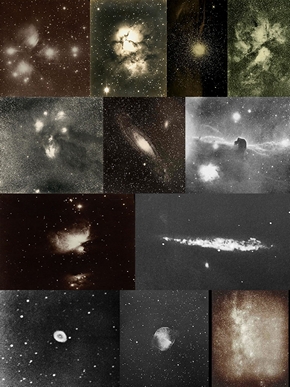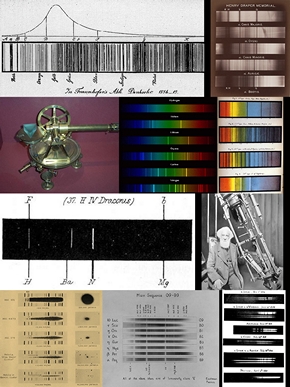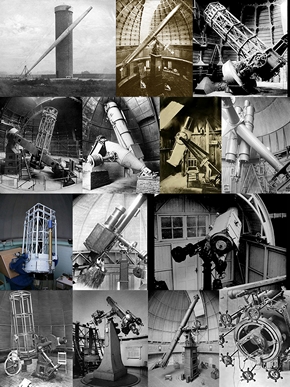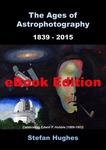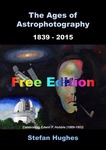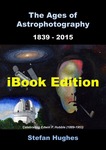 
|
|

Ages of Astrophotography
 As a young boy growing up in awe of the stars, I suffered a great disappointment and frustration - for I could never truly see the universe as it was in the photographs of my books. Through the eyepieces of my telescopes, which got bigger with each passing year I could only glimpse the myriad of stars of the two great globular clusters in Hercules; or pick out the faint ‘fuzzies’ that were star systems beyond our own Milky Way; or sense the magnificent glowing gas of the ‘Great Nebula’ in Orion - and when I looked for the dark head of the ‘Grim Reaper’s Horse’ rising into the light- I saw nothing, but the need for an even bigger telescope! I knew I could never have a ‘Great Reflector’ atop a Mountain or even an ageing Large Refractor at the edge of a City, so I gave up and became a Theoretical Astronomer where my only instruments were main frame computers programmed with the language of Mathematics, but I never forgot the wonder of the stars. Now half a century later, the modern amateur astronomer need not feel the disappointment or frustration as I did. Every night across the world in almost every country, in backyards, gardens, on hills or in deserts they image the heavens. With their modest equipment costing just a few thousand dollars they can see all that I could not; and with it capture the Night Sky with a quality far superior to the photographic plates taken by the ‘Great Telescopes’ in my books. The digital age of the CCD ‘Chip’ has arrived. My previous book the ‘Catchers of the Light’ told the story of the History of Astrophotography through the ‘Forgotten Lives of the Men and Women Who First Photographed the Heavens’. The present volume tells of the ‘Ages of Astrophotography’ through the images themselves. It features 100 of the most important, iconic and famous of astronomical objects, instruments, surveys, telescopes and cameras. For each ‘object’ two images are depicted side by side, one taken by an early Pioneer of Astrophotography and a second imaged by one of today’s finest Astronomical Photographers. Whenever possible the modern image is taken with the same ‘framing’ as that of the earlier photograph. Through these 100 objects the History of Astrophotography is told from the Age of the first Daguerreotypes up until the present Age of the CCD camera. The following 'objects' are included in the Book:
The book is divided into nine parts covering every aspect of the subject from its Origins, the Moon, Sun, Solar System, Deep Space, Spectroscopy, Photographic Sky Surveys, Telescopes and the Digital Age. Each part begins with a historical overview and also 'showcases' a modern day imager, renowned for their photographs of the objects featured. It is entirely fitting that ‘Ages of Astrophotography’ should have a ‘Past & Present’ theme and feature the images of both the early Pioneers of Astronomical Photography and their Modern Counterparts - for they have each seen the Spiral Nature of Galaxies, witnessed the magnificence of the Globulars, looked upon the beauty of the Gaseous Nebulae and even captured the ‘Grim Reaper’s’ Horse. It is for them this book has been written, so that anyone with even a passing interest in the Stars can learn of how they became the ‘Catchers of the Light’ - and in doing so wrote the History of Astrophotography. The year 2015 represents a milestone in Astrophotography, for it marks 125+ years since the birth of Edwin Powell Hubble (1889-1953) and 25 years since the launch of the great space telescope which bears his name. In 1923 Hubble made the most important astronomical discovery using photography of all time, when he imaged a Cepheid Variable star in the ‘Great Andromeda Spiral’; and in doing solved the ‘problem of the nebulae’ and proved that Lord Rosse’s ‘Spirals’ were ‘island universes lying behind the confines of our own Milky Way star system. It was this photograph which laid a ‘yardstick’ on the size of the universe. This book has been written as a tribute to Edwin Powell Hubble’s memory - and to honour him as probably the greatest of all the ‘Catchers of the Light’. Stefan Hughes, Pafos, Cyprus, 2015. 
NOW AVAILABLE. A NEW History of Astrophotography eBook for PC, Android & Browsers, told through 'Past & Present' Images. Over 500 A4 Pages in FULL Colour.
AOA.e
£39.99
NOW AVAILABLE. A FREE eBook Edition of the NEW History of Astrophotography for PC, Mac, iPad, Android & Kindle.
AOA.f
NOW AVAILABLE. A NEW History of Astrophotography iBook for Mac or iPad, told through 'Past & Present' Images taken by the Early Pioneers and Modern Day Astrophotographers.
iBook AOA.i
|
|
|

Dr. Stefan Hughes began his career as a professional astronomer, gaining a 1st Class Honours degree in Astronomy from the University of Leicester in 1974 and his PhD four years later on the 'Resonance Orbits of Artificial Satellites due to Lunisolar Perturbations', which was published as a series of papers in the Proceedings of the Royal Society of London. After graduating he became a Research fellow in Astronomy, followed by a spell as a lecturer in Applied Mathematics at Queen Mary College, London. Then came a ten year long career as an IT Consultant. In 'mid life' he spent several years retraining as a Genealogist, Record Agent and Architectural Historian, which he practiced for a number of years before moving to the Mediterranean island of Cyprus, where for the past ten years he has been imaging the heavens, as well as researching and writing the 'Catchers of the Light' - A History of Astrophotography.


